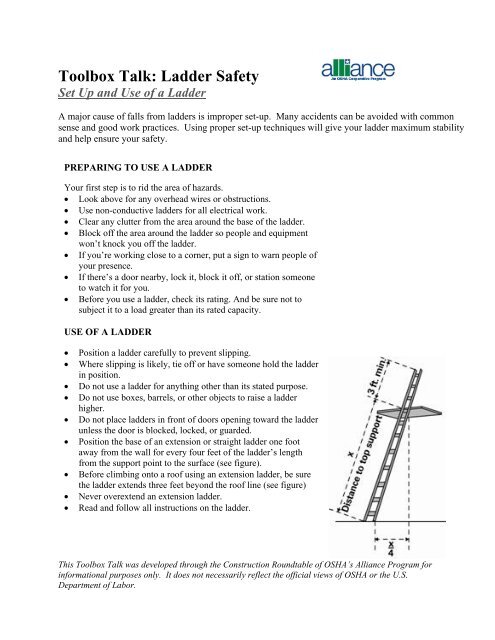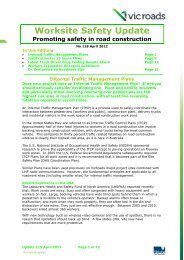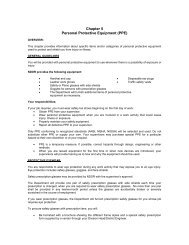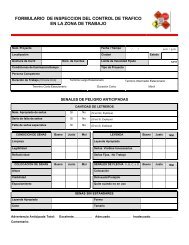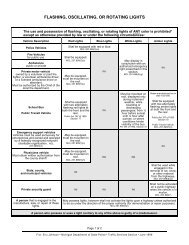Toolbox Talk: Ladder Safety - National Work Zone Safety Information ...
Toolbox Talk: Ladder Safety - National Work Zone Safety Information ...
Toolbox Talk: Ladder Safety - National Work Zone Safety Information ...
- No tags were found...
Create successful ePaper yourself
Turn your PDF publications into a flip-book with our unique Google optimized e-Paper software.
<strong>Toolbox</strong> <strong>Talk</strong>: <strong>Ladder</strong> <strong>Safety</strong>Set Up and Use of a <strong>Ladder</strong>A major cause of falls from ladders is improper set-up. Many accidents can be avoided with commonsense and good work practices. Using proper set-up techniques will give your ladder maximum stabilityand help ensure your safety.PREPARING TO USE A LADDERYour first step is to rid the area of hazards.• Look above for any overhead wires or obstructions.• Use non-conductive ladders for all electrical work.• Clear any clutter from the area around the base of the ladder.• Block off the area around the ladder so people and equipmentwon’t knock you off the ladder.• If you’re working close to a corner, put a sign to warn people ofyour presence.• If there’s a door nearby, lock it, block it off, or station someoneto watch it for you.• Before you use a ladder, check its rating. And be sure not tosubject it to a load greater than its rated capacity.USE OF A LADDER• Position a ladder carefully to prevent slipping.• Where slipping is likely, tie off or have someone hold the ladderin position.• Do not use a ladder for anything other than its stated purpose.• Do not use boxes, barrels, or other objects to raise a ladderhigher.• Do not place ladders in front of doors opening toward the ladderunless the door is blocked, locked, or guarded.• Position the base of an extension or straight ladder one footaway from the wall for every four feet of the ladder’s lengthfrom the support point to the surface (see figure).• Before climbing onto a roof using an extension ladder, be surethe ladder extends three feet beyond the roof line (see figure)• Never overextend an extension ladder.• Read and follow all instructions on the ladder.This <strong>Toolbox</strong> <strong>Talk</strong> was developed through the Construction Roundtable of OSHA’s Alliance Program forinformational purposes only. It does not necessarily reflect the official views of OSHA or the U.S.Department of Labor.
Discussion leader duties:Obtain a ladder that you or anemployee can use during thediscussion to demonstrate key points.What this <strong>Toolbox</strong> <strong>Talk</strong> covers:This toolbox talk covers the setup anduse of ladders.Review Questions: True or False1) If the ladder’s length from the ground tothe top support point is 20 feet, the baseshould be five feet from the building.TRUE: The base should be one foot awayfrom the wall for every four feet of theladder’s length from the ground to thesupport point.2) If you’re using a ladder to climb onto aroof, the ladder should extend one foot pastthe roof line.FALSE: The ladder should extend threefeet beyond the roof line.<strong>Talk</strong> Given By: ________________________ Date: ______________________Company: ____________________________ Location: __________________Printed NameSignatureThis <strong>Toolbox</strong> <strong>Talk</strong> was developed through the Construction Roundtable of OSHA’s Alliance Program forinformational purposes only. It does not necessarily reflect the official views of OSHA or the U.S.Department of Labor.


